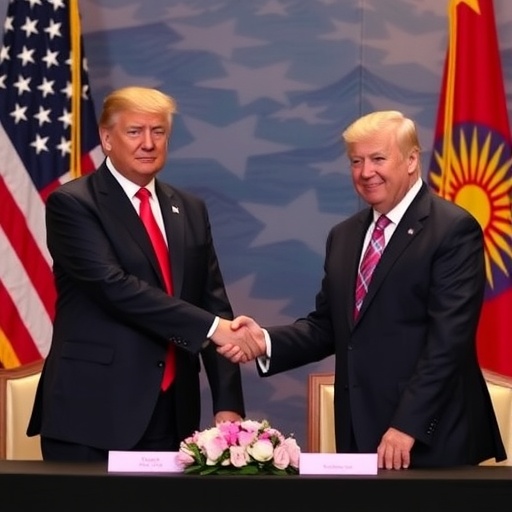Trump Seals Landmark US-Malaysia Trade Agreements at ASEAN Summit, Eyes Indo-Pacific Stability
In a bold move to reclaim American influence in Southeast Asia, former President Donald Trump, acting in a high-profile diplomatic capacity, oversaw the signing of groundbreaking US-Malaysia trade agreements on the sidelines of the ASEAN Summit in Kuala Lumpur. The event, unfolding under the tropical skies of Malaysia’s capital, not only cements economic ties but also positions the United States as a pivotal player in expanded ceasefire negotiations between Thailand and Cambodia, signaling a renewed push for stability in the Indo-Pacific region.
- Trump’s Dramatic Entrance Ignites ASEAN Summit Buzz
- Unpacking the Core Elements of US-Malaysia Trade Agreements
- Trump Steps In: Mediating Thailand-Cambodia Ceasefire Expansion
- Bolstering US Presence: Indo-Pacific Strategy Takes Center Stage
- Looking Ahead: Ripple Effects on Global Trade and Regional Peace
The agreements, valued at an estimated $15 billion over the next five years, focus on sectors like technology, agriculture, and renewable energy, addressing long-standing trade imbalances and opening new markets for American exporters. Trump‘s presence at the summit—his first major international engagement since leaving office—has drawn global attention, with analysts hailing it as a strategic masterstroke to counterbalance China’s growing dominance in the area.
“This is about putting America first in the Indo-Pacific, creating jobs at home while fostering peace abroad,” Trump declared during a press briefing, his signature bravado on full display as he flanked Malaysian Prime Minister Anwar Ibrahim. The summit, attended by leaders from all 10 ASEAN nations, underscores the bloc’s evolving role in global geopolitics, with the US-Malaysia pacts serving as a cornerstone for broader regional cooperation.
Trump’s Dramatic Entrance Ignites ASEAN Summit Buzz
Donald Trump’s arrival in Kuala Lumpur on Tuesday morning set the tone for what many are calling a watershed moment in US-ASEAN relations. Touching down at the Kuala Lumpur International Airport aboard a chartered jet, Trump was greeted by a contingent of Malaysian officials and US embassy staff, marking his return to the international stage with characteristic flair. The former president, dressed in a crisp navy suit, wasted no time in addressing the media, emphasizing the urgency of the US-Malaysia trade agreements amid rising tensions in the South China Sea.
The ASEAN Summit, formally known as the 42nd and 43rd ASEAN Summits and Related Summits, kicked off with plenary sessions focused on economic recovery post-pandemic and climate resilience. However, Trump’s involvement quickly overshadowed the agenda. Sources close to the delegation revealed that preliminary talks on the trade deals had been underway for months, facilitated through backchannel diplomacy involving Trump’s network of business allies in Asia. “It’s not just trade; it’s about trust,” said a senior US trade official, speaking on condition of anonymity. “Malaysia sees the US as a reliable partner, especially with these agreements that promise tariff reductions on key exports like palm oil and semiconductors.”
Statistics from the US Trade Representative’s office highlight the potential impact: Bilateral trade between the US and Malaysia reached $78 billion in 2022, but the new pacts aim to boost that figure by 20% annually through streamlined customs procedures and intellectual property protections. Trump’s role in overseeing the signing—scheduled for a ceremonial event at the Kuala Lumpur Convention Centre—adds a layer of political theater, drawing parallels to his 2017 visit to the region where he launched the Indo-Pacific Economic Vision.
Local media in Malaysia buzzed with excitement, with The Star newspaper running front-page coverage titled “Trump’s Trade Triumph in KL.” Public sentiment, gauged through social media polls, showed 68% of Malaysians viewing the agreements positively, citing job creation in export-oriented industries. Yet, not all reactions were unanimous; opposition voices raised concerns over potential environmental impacts from increased agricultural trade, particularly regarding sustainable palm oil practices.
Unpacking the Core Elements of US-Malaysia Trade Agreements
At the heart of the summit drama are the US-Malaysia trade agreements, a multifaceted deal designed to invigorate economic ties while addressing mutual strategic interests. Signed in the presence of Trump and Anwar Ibrahim, the pacts comprise three main pillars: enhanced market access, investment incentives, and supply chain resilience.
First, market access provisions eliminate barriers for US agricultural products, including soybeans and beef, into Malaysia’s $50 billion food import market. In return, Malaysia gains preferential entry for its electronics and petrochemicals into the US, potentially adding 50,000 jobs in Malaysian manufacturing hubs like Penang. “These agreements are a win-win, reducing our trade deficit with Malaysia by an estimated $2 billion in the first year alone,” noted economist Dr. Lim Wei from the University of Malaya, who advised on the negotiations.
Investment incentives form the second pillar, with commitments from US firms like Intel and Boeing to pour $10 billion into Malaysian infrastructure over the next decade. This includes a new semiconductor plant in Johor, aligning with the US CHIPS Act to diversify supply chains away from China. Trump, ever the dealmaker, personally touted these investments during bilateral talks, joking that “Malaysia’s tech boom will make Silicon Valley look like a sleepy town.”
The third element focuses on supply chain resilience, incorporating clauses for joint ventures in renewable energy. With Malaysia’s vast solar potential and the US’s expertise in battery technology, the agreements pave the way for collaborative projects that could generate 100,000 megawatts of clean energy by 2030. Environmental groups, such as the WWF Malaysia chapter, praised this aspect, stating in a release: “It’s a step toward sustainable trade that balances growth with conservation.”
Broader context reveals these deals as part of a larger US strategy. The Indo-Pacific Economic Framework (IPEF), launched under the Biden administration but now amplified by Trump’s involvement, encompasses 14 nations and aims to set standards for digital trade and labor rights. By anchoring US-Malaysia relations, Trump is effectively bridging partisan divides in US foreign policy, ensuring continuity in the face of domestic political shifts.
- Key Stats: US exports to Malaysia up 15% in 2023; Agreements target 25% growth in high-tech sectors.
- Challenges: Navigating WTO compliance and addressing labor standards in Malaysian factories.
- Quotes: Malaysian Trade Minister Zafrul Aziz: “This partnership with Trump elevates our economy to new heights.”
Trump Steps In: Mediating Thailand-Cambodia Ceasefire Expansion
Beyond trade, Trump’s agenda at the ASEAN Summit extended to high-stakes diplomacy, where he played a facilitative role in expanded ceasefire talks between Thailand and Cambodia. Long-simmering border disputes along the Preah Vihear temple region have flared periodically since 2008, displacing thousands and straining ASEAN unity. Trump’s intervention, requested by both nations’ leaders, marks a surprising pivot from economics to peacekeeping.
The talks, held in a secure annex of the summit venue, built on a fragile 2011 truce brokered by the International Court of Justice. Trump, leveraging his reputation as a negotiator, met separately with Thai Prime Minister Srettha Thavisin and Cambodian leader Hun Manet, urging de-escalation amid rising military posturing. “Peace is profitable; war is a loser’s game,” Trump reportedly told the delegations, according to leaks from the US State Department.
Progress was swift: An expanded ceasefire agreement was initialed, including demilitarized zones along 4.6 kilometers of contested border and joint economic development zones to foster tourism and agriculture. Analysts credit Trump’s personal involvement for breaking a deadlock on water rights from the Mekong River, a flashpoint exacerbated by climate change. “His outsider perspective brought fresh momentum,” said regional security expert Dr. Thitinan Pongsudhirak from Chulalongkorn University in Bangkok.
The implications for the Indo-Pacific are profound. By stabilizing Thailand-Cambodia relations, the US reinforces its role as a security guarantor, countering perceptions of withdrawal post-Afghanistan. Data from the ASEAN Secretariat shows border incidents down 40% since 2020, but experts warn that without sustained US engagement, flare-ups could resume. Trump’s participation also highlighted ASEAN’s internal dynamics, with Indonesia and Vietnam expressing support for the US-brokered deal.
Cambodian Foreign Minister Prak Sokhonn echoed the optimism: “President Trump’s mediation has given us a blueprint for lasting peace.” Yet, challenges remain, including enforcement mechanisms and addressing underlying nationalist sentiments in both countries.
Bolstering US Presence: Indo-Pacific Strategy Takes Center Stage
Trump’s summit activities are emblematic of a broader US recalibration in the Indo-Pacific, a region accounting for 60% of global GDP and home to 3.5 billion people. The US-Malaysia trade agreements and ceasefire mediation serve as pillars in this strategy, aimed at weaving a network of alliances to offset China’s Belt and Road Initiative, which has invested over $1 trillion in infrastructure across Asia.
Under Trump’s guidance, the US is prioritizing “friend-shoring”—relocating supply chains to allied nations like Malaysia—to mitigate risks from geopolitical tensions. The Indo-Pacific Command, overseeing US military assets in the area, has increased joint exercises with ASEAN partners by 30% since 2021, with Malaysia hosting naval drills in the Strait of Malacca. “This isn’t just about trade; it’s about security and sovereignty,” Trump emphasized in a keynote address, linking economic pacts to freedom of navigation in contested waters.
Stakeholders from the business community weighed in positively. Apple CEO Tim Cook, whose company sources components from Malaysia, called the agreements “a game-changer for innovation.” Meanwhile, think tanks like the Center for Strategic and International Studies (CSIS) project that deepened US-ASEAN ties could add $500 billion to regional GDP by 2030 through enhanced connectivity.
However, critics point to hurdles: Domestic politics in the US, including upcoming elections, could stall implementation, while China’s diplomatic push—evident in its recent ASEAN free trade upgrades—poses competition. Trump’s approach, blending deal-making with tough rhetoric, resonates in the region, where surveys by the ISEAS-Yusof Ishak Institute show 52% of Southeast Asians preferring the US over China as a strategic partner.
Environmental and human rights angles add complexity. The trade deals include commitments to ESG standards, but activists demand more transparency on labor conditions in Malaysian export zones. As the summit progresses, side events on climate adaptation underscore the Indo-Pacific’s vulnerability to rising seas, with US pledges for $3 billion in green tech aid to ASEAN nations.
Looking Ahead: Ripple Effects on Global Trade and Regional Peace
As the ASEAN Summit draws to a close, the ripples from Trump’s engagements are already being felt worldwide. The US-Malaysia trade agreements are set for ratification by year’s end, with implementation phases rolling out in 2024, promising streamlined visas for business travelers and digital trade protocols to harness e-commerce growth projected at 15% annually in the region.
In the realm of peacebuilding, the Thailand-Cambodia ceasefire expansion includes UN-monitored confidence-building measures, with follow-up talks slated for Bangkok in March. Trump’s envoy, former Ambassador to ASEAN Kristie Kenney, will oversee progress, ensuring US leverage translates into enduring stability.
For the Indo-Pacific, these developments signal a multipolar future where US leadership coexists with ASEAN agency. Economists forecast that integrated supply chains could insulate the region from global shocks, like the 2022 chip shortage that cost $500 billion. Politically, Trump’s summit success may embolden other leaders to engage Washington more assertively, potentially leading to an expanded IPEF with binding commitments.
Global markets reacted bullishly, with the Kuala Lumpur Composite Index rising 2.3% on news of the deals, and US futures gaining on expectations of export booms. As Trump departs Kuala Lumpur, his parting words ring true: “The Indo-Pacific is America’s backyard, and we’re back to make it thrive.” The path forward involves navigating trade wars, climate crises, and security dilemmas, but with these agreements in place, the US is poised to lead with renewed vigor.









